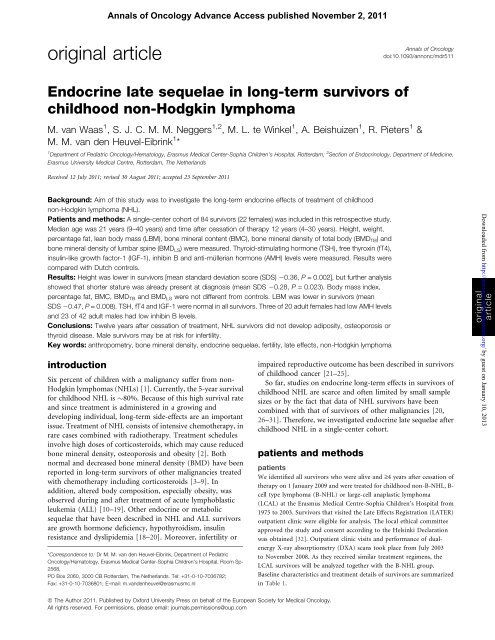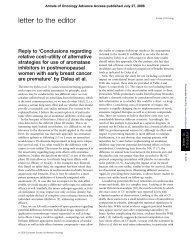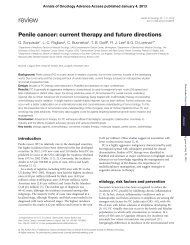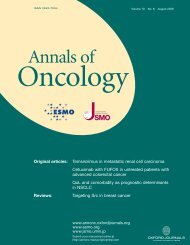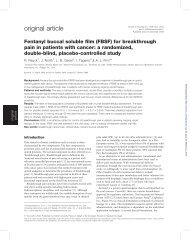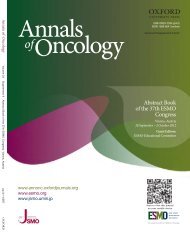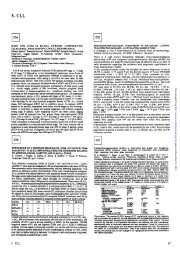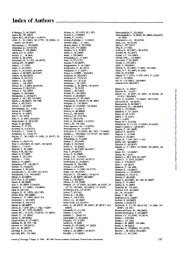Endocrine late sequelae in long-term survivors of childhood non ...
Endocrine late sequelae in long-term survivors of childhood non ...
Endocrine late sequelae in long-term survivors of childhood non ...
You also want an ePaper? Increase the reach of your titles
YUMPU automatically turns print PDFs into web optimized ePapers that Google loves.
orig<strong>in</strong>al article<br />
<strong>Endocr<strong>in</strong>e</strong> <strong>late</strong> <strong>sequelae</strong> <strong>in</strong> <strong>long</strong>-<strong>term</strong> <strong>survivors</strong> <strong>of</strong><br />
<strong>childhood</strong> <strong>non</strong>-Hodgk<strong>in</strong> lymphoma<br />
Annals <strong>of</strong> Oncology<br />
doi:10.1093/an<strong>non</strong>c/mdr511<br />
M. van Waas 1 , S. J. C. M. M. Neggers 1,2 , M. L. te W<strong>in</strong>kel 1 , A. Beishuizen 1 , R. Pieters 1 &<br />
M. M. van den Heuvel-Eibr<strong>in</strong>k 1 *<br />
1 2<br />
Department <strong>of</strong> Pediatric Oncology/Hematology, Erasmus Medical Center-Sophia Children’s Hospital, Rotterdam; Section <strong>of</strong> Endocr<strong>in</strong>ology, Department <strong>of</strong> Medic<strong>in</strong>e,<br />
Erasmus University Medical Centre, Rotterdam, The Netherlands<br />
Received 12 July 2011; revised 30 August 2011; accepted 23 September 2011<br />
Background: Aim <strong>of</strong> this study was to <strong>in</strong>vestigate the <strong>long</strong>-<strong>term</strong> endocr<strong>in</strong>e effects <strong>of</strong> treatment <strong>of</strong> <strong>childhood</strong><br />
<strong>non</strong>-Hodgk<strong>in</strong> lymphoma (NHL).<br />
Patients and methods: A s<strong>in</strong>gle-center cohort <strong>of</strong> 84 <strong>survivors</strong> (22 females) was <strong>in</strong>cluded <strong>in</strong> this retrospective study.<br />
Median age was 21 years (9–40 years) and time after cessation <strong>of</strong> therapy 12 years (4–30 years). Height, weight,<br />
percentage fat, lean body mass (LBM), bone m<strong>in</strong>eral content (BMC), bone m<strong>in</strong>eral density <strong>of</strong> total body (BMDTB) and<br />
bone m<strong>in</strong>eral density <strong>of</strong> lumbar sp<strong>in</strong>e (BMD LS) were measured. Thyroid-stimulat<strong>in</strong>g hormone (TSH), free thyrox<strong>in</strong> (fT4),<br />
<strong>in</strong>sul<strong>in</strong>-like growth factor-1 (IGF-1), <strong>in</strong>hib<strong>in</strong> B and anti-müllerian hormone (AMH) levels were measured. Results were<br />
compared with Dutch controls.<br />
Results: Height was lower <strong>in</strong> <strong>survivors</strong> [mean standard deviation score (SDS) 20.36, P = 0.002], but further analysis<br />
showed that shorter stature was already present at diagnosis (mean SDS 20.28, P = 0.023). Body mass <strong>in</strong>dex,<br />
percentage fat, BMC, BMDTB and BMD LS were not different from controls. LBM was lower <strong>in</strong> <strong>survivors</strong> (mean<br />
SDS 20.47, P = 0.008). TSH, fT4 and IGF-1 were normal <strong>in</strong> all <strong>survivors</strong>. Three <strong>of</strong> 20 adult females had low AMH levels<br />
and 23 <strong>of</strong> 42 adult males had low <strong>in</strong>hib<strong>in</strong> B levels.<br />
Conclusions: Twelve years after cessation <strong>of</strong> treatment, NHL <strong>survivors</strong> did not develop adiposity, osteoporosis or<br />
thyroid disease. Male <strong>survivors</strong> may be at risk for <strong>in</strong>fertility.<br />
Key words: anthropometry, bone m<strong>in</strong>eral density, endocr<strong>in</strong>e <strong>sequelae</strong>, fertility, <strong>late</strong> effects, <strong>non</strong>-Hodgk<strong>in</strong> lymphoma<br />
<strong>in</strong>troduction<br />
Annals <strong>of</strong> Oncology Advance Access published November 2, 2011<br />
Six percent <strong>of</strong> children with a malignancy suffer from <strong>non</strong>-<br />
Hodgk<strong>in</strong> lymphomas (NHLs) [1]. Currently, the 5-year survival<br />
for <strong>childhood</strong> NHL is 80%. Because <strong>of</strong> this high survival rate<br />
and s<strong>in</strong>ce treatment is adm<strong>in</strong>istered <strong>in</strong> a grow<strong>in</strong>g and<br />
develop<strong>in</strong>g <strong>in</strong>dividual, <strong>long</strong>-<strong>term</strong> side-effects are an important<br />
issue. Treatment <strong>of</strong> NHL consists <strong>of</strong> <strong>in</strong>tensive chemotherapy, <strong>in</strong><br />
rare cases comb<strong>in</strong>ed with radiotherapy. Treatment schedules<br />
<strong>in</strong>volve high doses <strong>of</strong> corticosteroids, which may cause reduced<br />
bone m<strong>in</strong>eral density, osteoporosis and obesity [2]. Both<br />
normal and decreased bone m<strong>in</strong>eral density (BMD) have been<br />
reported <strong>in</strong> <strong>long</strong>-<strong>term</strong> <strong>survivors</strong> <strong>of</strong> other malignancies treated<br />
with chemotherapy <strong>in</strong>clud<strong>in</strong>g corticosteroids [3–9]. In<br />
addition, altered body composition, especially obesity, was<br />
observed dur<strong>in</strong>g and after treatment <strong>of</strong> acute lymphoblastic<br />
leukemia (ALL) [10–19]. Other endocr<strong>in</strong>e or metabolic<br />
<strong>sequelae</strong> that have been described <strong>in</strong> NHL and ALL <strong>survivors</strong><br />
are growth hormone deficiency, hypothyroidism, <strong>in</strong>sul<strong>in</strong><br />
resistance and dyslipidemia [18–20]. Moreover, <strong>in</strong>fertility or<br />
*Correspondence to: Dr M. M. van den Heuvel-Eibr<strong>in</strong>k, Department <strong>of</strong> Pediatric<br />
Oncology/Hematology, Erasmus Medical Center-Sophia Children’s Hospital, Room Sp-<br />
2568,<br />
PO Box 2060, 3000 CB Rotterdam, The Netherlands. Tel: +31-0-10-7036782;<br />
Fax: +31-0-10-7036801; E-mail: m.vandenheuvel@erasmusmc.nl<br />
impaired reproductive outcome has been described <strong>in</strong> <strong>survivors</strong><br />
<strong>of</strong> <strong>childhood</strong> cancer [21–25].<br />
So far, studies on endocr<strong>in</strong>e <strong>long</strong>-<strong>term</strong> effects <strong>in</strong> <strong>survivors</strong> <strong>of</strong><br />
<strong>childhood</strong> NHL are scarce and <strong>of</strong>ten limited by small sample<br />
sizes or by the fact that data <strong>of</strong> NHL <strong>survivors</strong> have been<br />
comb<strong>in</strong>ed with that <strong>of</strong> <strong>survivors</strong> <strong>of</strong> other malignancies [20,<br />
26–31]. Therefore, we <strong>in</strong>vestigated endocr<strong>in</strong>e <strong>late</strong> <strong>sequelae</strong> after<br />
<strong>childhood</strong> NHL <strong>in</strong> a s<strong>in</strong>gle-center cohort.<br />
patients and methods<br />
ª The Author 2011. Published by Oxford University Press on behalf <strong>of</strong> the European Society for Medical Oncology.<br />
All rights reserved. For permissions, please email: journals.permissions@oup.com<br />
patients<br />
We identified all <strong>survivors</strong> who were alive and ‡4 years after cessation <strong>of</strong><br />
therapy on 1 January 2009 and were treated for <strong>childhood</strong> <strong>non</strong>-B-NHL, Bcell<br />
type lymphoma (B-NHL) or large-cell anaplastic lymphoma<br />
(LCAL) at the Erasmus Medical Centre-Sophia Children’s Hospital from<br />
1975 to 2003. Survivors that visited the Late Effects Registration (LATER)<br />
outpatient cl<strong>in</strong>ic were eligible for analysis. The local ethical committee<br />
approved the study and consent accord<strong>in</strong>g to the Hels<strong>in</strong>ki Declaration<br />
was obta<strong>in</strong>ed [32]. Outpatient cl<strong>in</strong>ic visits and performance <strong>of</strong> dualenergy<br />
X-ray absorptiometry (DXA) scans took place from July 2003<br />
to November 2008. As they received similar treatment regimens, the<br />
LCAL <strong>survivors</strong> will be analyzed together with the B-NHL group.<br />
Basel<strong>in</strong>e characteristics and treatment details <strong>of</strong> <strong>survivors</strong> are summarized<br />
<strong>in</strong> Table 1.<br />
Downloaded from<br />
http://an<strong>non</strong>c.oxfordjournals.org/ by guest on January 10, 2013<br />
orig<strong>in</strong>al<br />
article
orig<strong>in</strong>al article<br />
Table 1. Basel<strong>in</strong>e characteristics <strong>of</strong> NHL <strong>survivors</strong><br />
NHL <strong>survivors</strong> Non-B-NHL B-NHL + LCAL<br />
N (male/female) 84 (62/22) 32 (22/10) 52 (40/12)<br />
Age at follow-up (years) a<br />
21 (9–40) 23 (9–37) 20 (10–40)<br />
Age at diagnosis (years) a<br />
8 (2–16) 8 (2–16) 8 (2–16)<br />
Duration <strong>of</strong> treatment<br />
13 (1–38) 24 (4–38) 6 (1–28)<br />
(months) a<br />
Follow-up time (years) a<br />
Specification <strong>of</strong><br />
12 (4–30) 14 (4–25) 9 (5–30)<br />
chemotherapy n (%) TCD (mg/m 2 ) n (%) TCD (mg/m 2 ) n (%) TCD (mg/m 2 )<br />
Methotrexate 79 (94) 15 000 (1500–30 000) 31 (97) 6900 (1500–20 000) 48 (92) 15 000 (1500–30 000)<br />
V<strong>in</strong>crist<strong>in</strong>e 78 (93) 11 (2–141) 32 (100) 18 (7–141) 46 (88) 9 (2–25)<br />
Cytarab<strong>in</strong>e 76 (90) 1800 (1000–42 500) 28 (88) 3000 (1200–9800) 45 (87) 1800 (1000–42 500)<br />
Corticosteroids b<br />
71 (85) 3413 (710–28 670) 30 (94) 4407 (1840–26 490) 39 (75) 1418 (700–28 670)<br />
Anthracycl<strong>in</strong>es 65 (77) 180 (60–480) 29 (91) 280 (160–480) 36 (69) 180 (60–480)<br />
Cyclophosphamide 69 (82) 5500 (360–16 200) 18 (56) 3000 (2000–6000) 51 (98) 5800 (360–16 200)<br />
Ifosfamide 9 (11) 12 000 (4000–16 000) 1 (3) 4000 (NA) 8 (15) 120 000 (6000–16 000)<br />
Busulfan 1 (1) 480 (NA) 0 NA 1 (2) 480 (NA)<br />
Melphalan 1 (1) 140 (NA) 0 NA 1 (2) 140 (NA)<br />
a Median (range).<br />
b TCD prednisone plus TCD dexamethasone (dexamethasone was converted to prednisone us<strong>in</strong>g factor 6.67).<br />
NHL, <strong>non</strong>-Hodgk<strong>in</strong> lymphoma; LCAL, large-cell anaplastic lymphoma; TCD, total cumulative doses; NA, not applicable.<br />
anthropometry<br />
Height was measured us<strong>in</strong>g a Harpenden stadiometer and compared with<br />
Dutch normative values [33]. Height <strong>of</strong> <strong>survivors</strong> <strong>of</strong> other ethnicities<br />
was compared with normative values for these ethnicities [34, 35]. No data<br />
on target height were available. Weight was measured on a standard cl<strong>in</strong>ical<br />
balance. Body mass <strong>in</strong>dex (BMI) was calcu<strong>late</strong>d as weight (kg)/[height<br />
(m)] 2 . BMI <strong>of</strong> <strong>survivors</strong>
Annals <strong>of</strong> Oncology orig<strong>in</strong>al article<br />
results<br />
patients<br />
N<strong>in</strong>ety-two <strong>long</strong>-<strong>term</strong> NHL <strong>survivors</strong> were identified, <strong>of</strong> whom<br />
84 visited the outpatient cl<strong>in</strong>ic and could be analyzed (Figure 1).<br />
Sixty-two males and 22 females were identified, consistent with<br />
the <strong>in</strong>cidence <strong>of</strong> NHL (NHL occurs two to three times as <strong>of</strong>ten<br />
<strong>in</strong> males as <strong>in</strong> females). Thirty-two <strong>of</strong> the 84 <strong>survivors</strong> were<br />
diagnosed <strong>non</strong>-B-NHL, 46 B-NHL and 6 LCAL. Seventy-six<br />
<strong>survivors</strong> were Dutch, 4 Moroccan, 3 Turkish and 1 Asian.<br />
Median age at diagnosis was 8 years (range 2–16 years) and at<br />
follow-up 21 years (range 9–40 years). Thirty-six subjects<br />
(6 females) were aged
orig<strong>in</strong>al article<br />
Table 3. De<strong>term</strong><strong>in</strong>ants <strong>of</strong> height <strong>in</strong> NHL <strong>survivors</strong><br />
Variable Height (SDS)<br />
ß P value 95% CI<br />
All <strong>survivors</strong> a<br />
Age at follow-up 0.01 0.556 20.02 to 0.04<br />
Sex (male) 0.26 0.319 20.25 to 0.77<br />
Type <strong>of</strong> NHL b<br />
Survivors with a DXA scan available<br />
0.13 0.582 20.33 to 0.59<br />
c<br />
Age at follow-up 0.24 0.815 20.03 to 0.04<br />
Sex (male) 0.00 0.303 20.23 to 0.72<br />
Type <strong>of</strong> NHL 0.16 0.482 20.30 to 0.62<br />
LBM 0.68
Annals <strong>of</strong> Oncology orig<strong>in</strong>al article<br />
able to assess these dynamic tests. It should, moreover, be<br />
considered that these tests are more <strong>in</strong>vasive for the <strong>survivors</strong>,<br />
time consum<strong>in</strong>g and therefore expensive.<br />
Adiposity has been frequently reported not only <strong>in</strong> leukemia<br />
but also <strong>in</strong> lymphoma <strong>survivors</strong> [11, 30, 31]. In the present<br />
study, we found normal BMI and normal percentage fat <strong>in</strong><br />
NHL <strong>survivors</strong>. Hypothyroidism, which can contribute to<br />
obesity and is reported <strong>in</strong> <strong>survivors</strong>, especially after local<br />
radiotherapy [49–51], did not occur <strong>in</strong> this group <strong>of</strong> <strong>survivors</strong>.<br />
In patients treated for <strong>childhood</strong> cancer, treatment can have<br />
a deleterious effect on the acquisition <strong>of</strong> peak bone mass,<br />
subsequently <strong>in</strong>creas<strong>in</strong>g the risk <strong>of</strong> fractures at an older age.<br />
Reduced BMD has been described <strong>in</strong> adolescent and adult NHL<br />
<strong>survivors</strong> after stem-cell transplantation [52] and <strong>in</strong> <strong>childhood</strong><br />
NHL <strong>survivors</strong> after chemotherapy comb<strong>in</strong>ed with cranial<br />
radiotherapy [9, 29]. In our study, which is the largest cohort <strong>of</strong><br />
<strong>long</strong>-<strong>term</strong> <strong>childhood</strong> NHL <strong>survivors</strong>, BMD TB and BMD LS were<br />
with<strong>in</strong> the normal range. BMD LS was still normal after<br />
correction for bone size (BMAD LS). This was <strong>in</strong> concordance<br />
with the f<strong>in</strong>d<strong>in</strong>gs <strong>in</strong> <strong>long</strong>-<strong>term</strong> <strong>survivors</strong> <strong>of</strong> <strong>childhood</strong> ALL [9].<br />
When <strong>in</strong>terpret<strong>in</strong>g these results, one should consider the<br />
retrospective nature <strong>of</strong> this study and the small sample sizes <strong>of</strong><br />
the subgroups. However, as the majority <strong>of</strong> our NHL <strong>survivors</strong><br />
were treated with chemotherapy only, these results seem<br />
comprehensible.<br />
Infertility has been frequently reported <strong>in</strong> <strong>childhood</strong> cancer<br />
<strong>survivors</strong> [21–23]. Additionally, low AMH or <strong>in</strong>hib<strong>in</strong> B levels,<br />
which are fertility markers, have been reported [24, 25].<br />
Notorious for caus<strong>in</strong>g <strong>in</strong>fertility are abdom<strong>in</strong>al radiotherapy<br />
and alkylat<strong>in</strong>g chemotherapeutic agents, like cyclophosphamide<br />
[21, 22]. Moreover, cytarab<strong>in</strong>e has been described to contribute<br />
to gonadal damage <strong>in</strong> <strong>survivors</strong> <strong>of</strong> adult acute myeloid<br />
leukemia [53]. However, this was not confirmed <strong>in</strong> female<br />
<strong>childhood</strong> cancer <strong>survivors</strong> [21] and <strong>in</strong> male <strong>childhood</strong> cancer<br />
<strong>survivors</strong>, even a reversed effect was described [22]. In the<br />
present study, 3 <strong>of</strong> 20 adult female <strong>survivors</strong> had abnormal<br />
AMH levels. Two <strong>of</strong> three received both cyclophosphamide and<br />
cytarab<strong>in</strong>e; however, <strong>non</strong>e <strong>of</strong> them received cranial or<br />
abdom<strong>in</strong>al radiotherapy. Interest<strong>in</strong>gly, <strong>in</strong>hib<strong>in</strong> B levels were<br />
low <strong>in</strong> 55% <strong>of</strong> adult male <strong>survivors</strong>. High FSH levels <strong>in</strong> these<br />
<strong>survivors</strong> confirm that this is not a problem <strong>of</strong> pituitary or<br />
hypothalamus but <strong>of</strong> local orig<strong>in</strong>. After correction for age at<br />
diagnosis and total cumulative dose <strong>of</strong> alkylat<strong>in</strong>g agents,<br />
cytarab<strong>in</strong>e had a significant negative effect on <strong>in</strong>hib<strong>in</strong> B levels <strong>in</strong><br />
adult males. Although groups are small and results should<br />
therefore be <strong>in</strong>terpreted with caution, this effect seems<br />
substantial and has not been reported previously. Our results<br />
contradict those <strong>of</strong> Green et al. [22], which may be due to<br />
differences <strong>in</strong> reported outcomes (sir<strong>in</strong>g a pregnancy versus<br />
fertility markers). Inhib<strong>in</strong> B is a relatively new fertility marker<br />
but has been shown to be the most reliable serum marker<br />
for spermatogenesis [43, 54–57]. Prospective studies are needed<br />
to confirm these data, preferably with larger cohorts and<br />
<strong>in</strong>clud<strong>in</strong>g both <strong>in</strong>hib<strong>in</strong> B measurements and sperm analysis.<br />
In conclusion, <strong>long</strong>-<strong>term</strong> <strong>childhood</strong> NHL <strong>survivors</strong>,<br />
especially males, have a shorter stature that seems to be<br />
de<strong>term</strong><strong>in</strong>ed by height at diagnosis and not by treatment-re<strong>late</strong>d<br />
side-effects. Otherwise, this study shows that <strong>long</strong>-<strong>term</strong><br />
<strong>childhood</strong> NHL <strong>survivors</strong> do not seem to be at risk for<br />
endocr<strong>in</strong>e <strong>late</strong> <strong>sequelae</strong> like osteoporosis, obesity and<br />
hypothyroidy. However, especially males might be at risk for<br />
gonadal damage, which may be re<strong>late</strong>d to the cumulative dose<br />
<strong>of</strong> cytarab<strong>in</strong>e. To evaluate gonadal damage both <strong>in</strong> male and<br />
female NHL <strong>survivors</strong>, prospective studies <strong>of</strong> larger cohorts are<br />
required.<br />
acknowledgements<br />
The authors would like to thank Wim C. J. Hop from the<br />
Department <strong>of</strong> Biostatistics for his valuable suggestions and<br />
comments and Manita M. M. P. G. M. van Baalen from the<br />
Department <strong>of</strong> Pediatric Oncology for help<strong>in</strong>g recruit<strong>in</strong>g data.<br />
Authorship—MMvdH-E was the pr<strong>in</strong>cipal <strong>in</strong>vestigator and<br />
takes primary responsibility for the paper. MvW participated <strong>in</strong><br />
the statistical analysis. SJCMMN, RP and MH coord<strong>in</strong>ated the<br />
research. MvW, SJCMMN and MMvdH-E wrote the paper.<br />
SJCMMN, MtW, AB, RP and MMvdH-E were <strong>in</strong>volved <strong>in</strong><br />
draft<strong>in</strong>g and revis<strong>in</strong>g the article.<br />
fund<strong>in</strong>g<br />
KiKa (K<strong>in</strong>deren Kankervrij; 2009-030); K<strong>in</strong>deroncologisch<br />
Centrum Rotterdam.<br />
disclosure<br />
The authors declare no conflict <strong>of</strong> <strong>in</strong>terest.<br />
references<br />
1. Reiter A. Diagnosis and treatment <strong>of</strong> <strong>childhood</strong> <strong>non</strong>-Hodgk<strong>in</strong> lymphoma.<br />
Hematology Am Soc Hematol Educ Program 2007; 2007: 285–296.<br />
2. Reid IR. Glucocorticoid osteoporosis—mechanisms and management. Eur J<br />
Endocr<strong>in</strong>ol 1997; 137: 209–217.<br />
3. van Beek RD, van den Heuvel-Eibr<strong>in</strong>k MM, Hakvoort-Cammel FG et al. Bone<br />
m<strong>in</strong>eral density, growth and thyroid function <strong>in</strong> <strong>long</strong>-<strong>term</strong> <strong>survivors</strong> <strong>of</strong> pediatric<br />
Hodgk<strong>in</strong>’s lymphoma treated with chemotherapy only. J Cl<strong>in</strong> Endocr<strong>in</strong>ol Metab<br />
2009; 94: 1904–1909.<br />
4. Arikoski P, Komula<strong>in</strong>en J, Voutila<strong>in</strong>en R et al. Reduced bone m<strong>in</strong>eral density <strong>in</strong><br />
<strong>long</strong>-<strong>term</strong> <strong>survivors</strong> <strong>of</strong> <strong>childhood</strong> acute lymphoblastic leukemia. J Pediatr<br />
Hematol Oncol 1998; 20: 234–240.<br />
5. Brennan BM, Rahim A, Adams JA et al. Reduced bone m<strong>in</strong>eral density <strong>in</strong> young<br />
adults follow<strong>in</strong>g cure <strong>of</strong> acute lymphoblastic leukaemia <strong>in</strong> <strong>childhood</strong>. Br J Cancer<br />
1999; 79: 1859–1863.<br />
6. Gilsanz V, Carlson ME, Roe TF, Ortega JA. Osteoporosis after cranial irradiation<br />
for acute lymphoblastic leukemia. J Pediatr 1990; 117: 238–244.<br />
7. Henderson RC, Madsen CD, Davis C, Gold SH. Bone density <strong>in</strong> <strong>survivors</strong> <strong>of</strong><br />
<strong>childhood</strong> malignancies. J Pediatr Hematol Oncol 1996; 18: 367–371.<br />
8. van der Sluis IM, van den Heuvel-Eibr<strong>in</strong>k MM, Hahlen K et al. Bone m<strong>in</strong>eral<br />
density, body composition, and height <strong>in</strong> <strong>long</strong>-<strong>term</strong> <strong>survivors</strong> <strong>of</strong> acute<br />
lymphoblastic leukemia <strong>in</strong> <strong>childhood</strong>. Med Pediatr Oncol 2000; 35: 415–420.<br />
9. Nysom K, Holm K, Hertz H et al. Bone mass after treatment for acute<br />
lymphoblastic leukemia <strong>in</strong> <strong>childhood</strong>. J Cl<strong>in</strong> Oncol 2001; 19: 2970–2971.<br />
10. van Beek RD, de Mu<strong>in</strong>ck Keizer-Schrama SM, Hakvoort-Cammel FG et al. No<br />
difference between prednisolone and dexamethasone treatment <strong>in</strong> bone m<strong>in</strong>eral<br />
density and growth <strong>in</strong> <strong>long</strong> <strong>term</strong> <strong>survivors</strong> <strong>of</strong> <strong>childhood</strong> acute lymphoblastic<br />
leukemia. Pediatr Blood Cancer 2006; 46: 88–93.<br />
11. Asner S, Ammann RA, Ozsah<strong>in</strong> H et al. Obesity <strong>in</strong> <strong>long</strong>-<strong>term</strong> <strong>survivors</strong> <strong>of</strong> <strong>childhood</strong><br />
acute lymphoblastic leukemia. Pediatr Blood Cancer 2008; 51: 118–122.<br />
12. Birkebaek NH, Clausen N. Height and weight pattern up to 20 years after treatment<br />
for acute lymphoblastic leukaemia. Arch Dis Child 1998; 79: 161–164.<br />
doi:10.1093/an<strong>non</strong>c/mdr511 | 5<br />
Downloaded from<br />
http://an<strong>non</strong>c.oxfordjournals.org/ by guest on January 10, 2013
orig<strong>in</strong>al article<br />
13. Jarfelt M, Lanner<strong>in</strong>g B, Bosaeus I et al. Body composition <strong>in</strong> young adult <strong>survivors</strong><br />
<strong>of</strong> <strong>childhood</strong> acute lymphoblastic leukaemia. Eur J Endocr<strong>in</strong>ol 2005; 153: 81–89.<br />
14. Oeff<strong>in</strong>ger KC, Buchanan GR, Eshelman DA et al. Cardiovascular risk factors <strong>in</strong><br />
young adult <strong>survivors</strong> <strong>of</strong> <strong>childhood</strong> acute lymphoblastic leukemia. J Pediatr<br />
Hematol Oncol 2001; 23: 424–430.<br />
15. Warner JT, Evans WD, Webb DK, Gregory JW. Body composition <strong>of</strong> <strong>long</strong>-<strong>term</strong><br />
<strong>survivors</strong> <strong>of</strong> acute lymphoblastic leukaemia. Med Pediatr Oncol 2002; 38:<br />
165–172.<br />
16. Brennan BM, Rahim A, Blum WF et al. Hyperlept<strong>in</strong>aemia <strong>in</strong> young adults<br />
follow<strong>in</strong>g cranial irradiation <strong>in</strong> <strong>childhood</strong>: growth hormone deficiency or lept<strong>in</strong><br />
<strong>in</strong>sensitivity? Cl<strong>in</strong> Endocr<strong>in</strong>ol (Oxf) 1999; 50: 163–169.<br />
17. Nysom K, Holm K, Michaelsen KF et al. Degree <strong>of</strong> fatness after treatment for<br />
acute lymphoblastic leukemia <strong>in</strong> <strong>childhood</strong>. J Cl<strong>in</strong> Endocr<strong>in</strong>ol Metab 1999; 84:<br />
4591–4596.<br />
18. van Waas M, Neggers SJ, Pieters R, van den Heuvel-Eibr<strong>in</strong>k MM. Components <strong>of</strong><br />
the metabolic syndrome <strong>in</strong> 500 adult <strong>long</strong>-<strong>term</strong> <strong>survivors</strong> <strong>of</strong> <strong>childhood</strong> cancer.<br />
Ann Oncol 2010; 21: 1121–1126.<br />
19. van Waas M, Neggers SJ, van der Lelij AJ et al. The metabolic syndrome <strong>in</strong> adult<br />
<strong>survivors</strong> <strong>of</strong> <strong>childhood</strong> cancer, a review. J Pediatr Hematol Oncol 2010; 32:<br />
171–179.<br />
20. Steffens M, Beauloye V, Brichard B et al. <strong>Endocr<strong>in</strong>e</strong> and metabolic disorders <strong>in</strong><br />
young adult <strong>survivors</strong> <strong>of</strong> <strong>childhood</strong> acute lymphoblastic leukaemia (ALL) or <strong>non</strong>-<br />
Hodgk<strong>in</strong> lymphoma (NHL). Cl<strong>in</strong> Endocr<strong>in</strong>ol (Oxf) 2008; 69: 819–827.<br />
21. Green DM, Kawashima T, Stovall M et al. Fertility <strong>of</strong> female <strong>survivors</strong> <strong>of</strong><br />
<strong>childhood</strong> cancer: a report from the <strong>childhood</strong> cancer survivor study. J Cl<strong>in</strong> Oncol<br />
2009; 27: 2677–2685.<br />
22. Green DM, Kawashima T, Stovall M et al. Fertility <strong>of</strong> male <strong>survivors</strong> <strong>of</strong> <strong>childhood</strong><br />
cancer: a report from the Childhood Cancer Survivor Study. J Cl<strong>in</strong> Oncol 2010;<br />
28: 332–339.<br />
23. Hudson MM. Reproductive outcomes for <strong>survivors</strong> <strong>of</strong> <strong>childhood</strong> cancer. Obstet<br />
Gynecol 2010; 116: 1171–1183.<br />
24. Lie Fong S, Laven JS, Hakvoort-Cammel FG et al. Assessment <strong>of</strong> ovarian reserve<br />
<strong>in</strong> adult <strong>childhood</strong> cancer <strong>survivors</strong> us<strong>in</strong>g anti-Mullerian hormone. Hum Reprod<br />
2009; 24: 982–990.<br />
25. van Casteren NJ, van der L<strong>in</strong>den GH, Hakvoort-Cammel FG et al. Effect <strong>of</strong><br />
<strong>childhood</strong> cancer treatment on fertility markers <strong>in</strong> adult male <strong>long</strong>-<strong>term</strong> <strong>survivors</strong>.<br />
Pediatr Blood Cancer 2009; 52: 108–112.<br />
26. Nysom K, Holm K, Michaelsen KF et al. Degree <strong>of</strong> fatness after treatment <strong>of</strong><br />
malignant lymphoma <strong>in</strong> <strong>childhood</strong>. Med Pediatr Oncol 2003; 40: 239–243.<br />
27. Muszynska-Roslan K, Konstantynowicz J, Krawczuk-Rybak M, Protas P. Body<br />
composition and bone mass <strong>in</strong> <strong>survivors</strong> <strong>of</strong> <strong>childhood</strong> cancer. Pediatr Blood<br />
Cancer 2007; 48: 200–204.<br />
28. Vassilopoulou-Sell<strong>in</strong> R, Brosnan P, Delpassand A et al. Osteopenia <strong>in</strong> young adult<br />
<strong>survivors</strong> <strong>of</strong> <strong>childhood</strong> cancer. Med Pediatr Oncol 1999; 32: 272–278.<br />
29. Sala A, Talsma D, Webber C et al. Bone m<strong>in</strong>eral status after treatment <strong>of</strong><br />
malignant lymphoma <strong>in</strong> <strong>childhood</strong> and adolescence. Eur J Cancer Care (Engl)<br />
2007; 16: 373–379.<br />
30. G<strong>of</strong>man I, Ducore J. Risk factors for the development <strong>of</strong> obesity <strong>in</strong> children<br />
surviv<strong>in</strong>g ALL and NHL. J Pediatr Hematol Oncol 2009; 31: 101–107.<br />
31. Razzouk BI, Rose SR, Hongeng S et al. Obesity <strong>in</strong> <strong>survivors</strong> <strong>of</strong> <strong>childhood</strong> acute<br />
lymphoblastic leukemia and lymphoma. J Cl<strong>in</strong> Oncol 2007; 25: 1183–1189.<br />
32. World Medical Association General Assembly. Declaration <strong>of</strong> Hels<strong>in</strong>ki—Sixth<br />
Revision. Hels<strong>in</strong>ki, F<strong>in</strong>land. 2008.<br />
33. Fredriks AM, van Buuren S, Burgmeijer RJ et al. Cont<strong>in</strong>u<strong>in</strong>g positive secular growth<br />
change <strong>in</strong> The Netherlands 1955–1997. Pediatr Res 2000; 47: 316–323.<br />
34. Fredriks AM, van Buuren S, Jeurissen SE et al. Height, weight, body mass <strong>in</strong>dex<br />
and pubertal development reference values for children <strong>of</strong> Turkish orig<strong>in</strong> <strong>in</strong> the<br />
Netherlands. Eur J Pediatr 2003; 162: 788–793.<br />
35. Fredriks AM, van Buuren S, Jeurissen SE et al. Height, weight, body mass <strong>in</strong>dex<br />
and pubertal development references for children <strong>of</strong> Moroccan orig<strong>in</strong> <strong>in</strong> The<br />
Netherlands. Acta Paediatr 2004; 93: 817–824.<br />
36. Blokstra A, Smit HA, Bueno de Mesquita HB et al. Monitor<strong>in</strong>g van Risic<strong>of</strong>actoren<br />
en Gezondheid <strong>in</strong> Nederland (MORGEN-project), 1993–1997. Rijks<strong>in</strong>stituut voor<br />
Volksgezondheid en Milieu (RIVM), Bilthoven, Netherlands. 1999.<br />
6 | van Waas et al.<br />
Annals <strong>of</strong> Oncology<br />
37. Kröger H, Va<strong>in</strong>io P, Niem<strong>in</strong>en J, Kotaniemi A. Comparison <strong>of</strong> different models for<br />
<strong>in</strong>terpret<strong>in</strong>g bone m<strong>in</strong>eral density measurements us<strong>in</strong>g DXA and MRI technology.<br />
Bone 1995; 17: 157–159.<br />
38. van der Sluis IM, de Ridder MA, Boot AM et al. Reference data for bone density<br />
and body composition measured with dual energy x ray absorptiometry <strong>in</strong> white<br />
children and young adults. Arch Dis Child 2002; 87: 341–347; discussion 341–<br />
347.<br />
39. Elml<strong>in</strong>ger MW, Kuhnel W, Weber MM, Ranke MB. Reference ranges for two<br />
automated chemilum<strong>in</strong>escent assays for serum <strong>in</strong>sul<strong>in</strong>-like growth factor I (IGF-I)<br />
and IGF-b<strong>in</strong>d<strong>in</strong>g prote<strong>in</strong> 3 (IGFBP-3). Cl<strong>in</strong> Chem Lab Med 2004; 42: 654–664.<br />
40. de Vet A, Laven JS, de Jong FH et al. Antimullerian hormone serum levels:<br />
a putative marker for ovarian ag<strong>in</strong>g. Fertil Steril 2002; 77: 357–362.<br />
41. Kevenaar ME, Meerasahib MF, Kramer P et al. Serum anti-mullerian hormone<br />
levels reflect the size <strong>of</strong> the primordial follicle pool <strong>in</strong> mice. Endocr<strong>in</strong>ology 2006;<br />
147: 3228–3234.<br />
42. van Casteren NJ, Dohle GR, Romijn JC et al. Semen cryopreservation <strong>in</strong> pubertal<br />
boys before gonadotoxic treatment and the role <strong>of</strong> endocr<strong>in</strong>ologic evaluation <strong>in</strong><br />
predict<strong>in</strong>g sperm yield. Fertil Steril 2008; 90: 1119–1125.<br />
43. Pierik FH, Burdorf A, de Jong FH, Weber RF. Inhib<strong>in</strong> B: a novel marker <strong>of</strong><br />
spermatogenesis. Ann Med 2003; 35: 12–20.<br />
44. Schriock EA, Schell MJ, Carter M et al. Abnormal growth patterns and adult short<br />
stature <strong>in</strong> 115 <strong>long</strong>-<strong>term</strong> <strong>survivors</strong> <strong>of</strong> <strong>childhood</strong> leukemia. J Cl<strong>in</strong> Oncol 1991; 9:<br />
400–405.<br />
45. Katz JA, Pollock BH, Jacaruso D, Morad A. F<strong>in</strong>al atta<strong>in</strong>ed height <strong>in</strong> patients<br />
successfully treated for <strong>childhood</strong> acute lymphoblastic leukemia. J Pediatr 1993;<br />
123: 546–552.<br />
46. Sklar C, Mertens A, Walter A et al. F<strong>in</strong>al height after treatment for <strong>childhood</strong><br />
acute lymphoblastic leukemia: comparison <strong>of</strong> no cranial irradiation with 1800<br />
and 2400 centigrays <strong>of</strong> cranial irradiation. J Pediatr 1993; 123: 59–64.<br />
47. Dalton VK, Rue M, Silverman LB et al. Height and weight <strong>in</strong> children treated for<br />
acute lymphoblastic leukemia: relationship to CNS treatment. J Cl<strong>in</strong> Oncol 2003;<br />
21: 2953–2960.<br />
48. Mulder RL, Kremer LC, van Santen HM et al. Prevalence and risk factors <strong>of</strong><br />
radiation-<strong>in</strong>duced growth hormone deficiency <strong>in</strong> <strong>childhood</strong> cancer <strong>survivors</strong>:<br />
a systematic review. Cancer Treat Rev 2009; 35: 616–632.<br />
49. Bonato C, Sever<strong>in</strong>o RF, Elnecave RH. Reduced thyroid volume and<br />
hypothyroidism <strong>in</strong> <strong>survivors</strong> <strong>of</strong> <strong>childhood</strong> cancer treated with radiotherapy.<br />
J Pediatr Endocr<strong>in</strong>ol Metab 2008; 21: 943–949.<br />
50. Miyoshi Y, Ohta H, Hashii Y et al. Endocr<strong>in</strong>ological analysis <strong>of</strong> 122 Japanese<br />
<strong>childhood</strong> cancer <strong>survivors</strong> <strong>in</strong> a s<strong>in</strong>gle hospital. Endocr J 2008; 55: 1055–1063.<br />
51. Stava CJ, Jimenez C, Vassilopoulou-Sell<strong>in</strong> R. <strong>Endocr<strong>in</strong>e</strong> <strong>sequelae</strong> <strong>of</strong> cancer and<br />
cancer treatments. J Cancer Surviv 2007; 1: 261–274.<br />
52. Majhail NS, Ness KK, Burns LJ et al. Late effects <strong>in</strong> <strong>survivors</strong> <strong>of</strong> Hodgk<strong>in</strong> and<br />
<strong>non</strong>-Hodgk<strong>in</strong> lymphoma treated with autologous hematopoietic cell<br />
transplantation: a report from the bone marrow transplant survivor study. Biol<br />
Blood Marrow Transplant 2007; 13: 1153–1159.<br />
53. Lemez P, Urbanek V. Chemotherapy for acute myeloid leukemias with cytos<strong>in</strong>e<br />
arab<strong>in</strong>oside, daunorubic<strong>in</strong>, etoposide, and mitoxantrone may cause permanent<br />
oligoasthenozoospermia or amenorrhea <strong>in</strong> middle-aged patients. Neoplasma<br />
2005; 52: 398–401.<br />
54. Pierik FH, Vreeburg JT, Stijnen T et al. Serum <strong>in</strong>hib<strong>in</strong> B as a marker <strong>of</strong><br />
spermatogenesis. J Cl<strong>in</strong> Endocr<strong>in</strong>ol Metab 1998; 83: 3110–3114.<br />
55. Kumanov P, Nandipati K, Tomova A, Agarwal A. Inhib<strong>in</strong> B is a better marker <strong>of</strong><br />
spermatogenesis than other hormones <strong>in</strong> the evaluation <strong>of</strong> male factor <strong>in</strong>fertility.<br />
Fertil Steril 2006; 86: 332–338.<br />
56. Kl<strong>in</strong>gmuller D, Haidl G. Inhib<strong>in</strong> B <strong>in</strong> men with normal and disturbed<br />
spermatogenesis. Hum Reprod 1997; 12: 2376–2378.<br />
57. van Beek RD, Smit M, van den Heuvel-Eibr<strong>in</strong>k MM et al. Inhib<strong>in</strong> B is superior to<br />
FSH as a serum marker for spermatogenesis <strong>in</strong> men treated for Hodgk<strong>in</strong>’s<br />
lymphoma with chemotherapy dur<strong>in</strong>g <strong>childhood</strong>. Hum Reprod 2007; 22:<br />
3215–3222.<br />
Downloaded from<br />
http://an<strong>non</strong>c.oxfordjournals.org/ by guest on January 10, 2013


